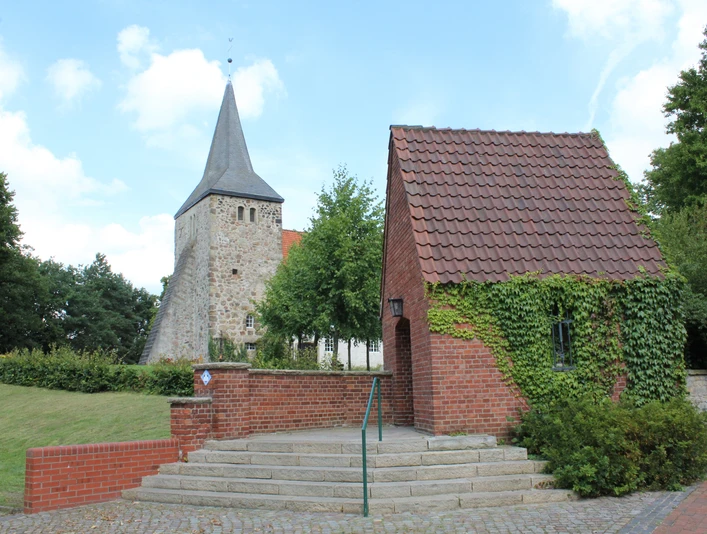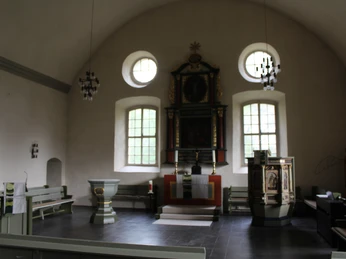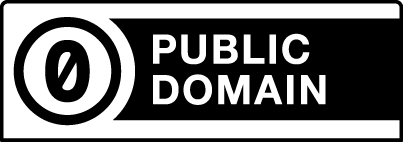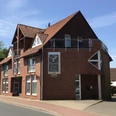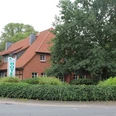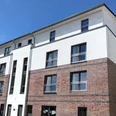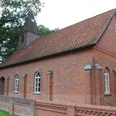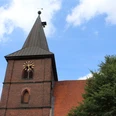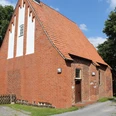- Photos & Map
How would you like to arrive?
- Call
- Description
- Good to know
- Nearby
Its patron saint is St. Dionysius. Exactly which saint of this name is meant is uncertain. It is probably a bishop from Paris who died as a martyr for his faith in the second or third century. He was beheaded and, according to legend, he then took his head in his hands and walked to his grave. This is why he is usually depicted as a bishop with his head in his hand - this depiction can also be seen on a window in the hall of honor that you pass through to get to the church. The names of all those from the parish of Steimbke who fell in the Second World War are immortalized on wooden plaques in this hall of honour.
The church tower, built from fieldstone, is the older part of the church. It has the character of a defensive tower into which the congregation could take refuge in case of danger. A walled-up door at a height of more than one meter still bears witness to this time, when the church was the only safe place of refuge. The exact date of the tower's construction is not known.
A document from 1310, in which the village of Steimbke is mentioned for the first time, also mentions a church in Steimbke. It is unclear what it looked like and whether any remains of it still exist and have been integrated into the current church building. In the south-east corner of the church there is an illegible Roman numeral (1469?) on the outside, the meaning of which is unknown. The date 1561 carved into the tower on the entrance side probably refers to a repair. The oldest church records in Steimbke date from after 1600, and it is only from then on that it is possible to make reliable statements.
The nave is a simple Baroque building with a barrel vault, and the date of its construction is known: After a violent storm that caused the spire to collapse onto the building on Christmas Day 1725, the nave was completely destroyed. The new construction that became necessary as a result was begun in 1727 - a date that can be read from the highlighted letters of the inscription on the entrance door on the south side. The church was reconsecrated on October 6, 1729 and received a new pulpit altar. In 1730, the stone baptismal font still used today was added.
The church tower, built from fieldstone, is the older part of the church. It has the character of a defensive tower into which the congregation could take refuge in case of danger. A walled-up door at a height of more than one meter still bears witness to this time, when the church was the only safe place of refuge. The exact date of the tower's construction is not known.
A document from 1310, in which the village of Steimbke is mentioned for the first time, also mentions a church in Steimbke. It is unclear what it looked like and whether any remains of it still exist and have been integrated into the current church building. In the south-east corner of the church there is an illegible Roman numeral (1469?) on the outside, the meaning of which is unknown. The date 1561 carved into the tower on the entrance side probably refers to a repair. The oldest church records in Steimbke date from after 1600, and it is only from then on that it is possible to make reliable statements.
The nave is a simple Baroque building with a barrel vault, and the date of its construction is known: After a violent storm that caused the spire to collapse onto the building on Christmas Day 1725, the nave was completely destroyed. The new construction that became necessary as a result was begun in 1727 - a date that can be read from the highlighted letters of the inscription on the entrance door on the south side. The church was reconsecrated on October 6, 1729 and received a new pulpit altar. In 1730, the stone baptismal font still used today was added.
Good to know
Author
Mittelweser-Touristik GmbH
Lange Straße 18
31582 Nienburg/Weser
Organization
Mittelweser-Touristik GmbH
License (master data)
Mittelweser-Touristik GmbH
Nearby
